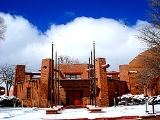
Navajo Nation Council Chamber
Encyclopedia
Navajo Nation Council Chambers is the center of government for the Navajo Nation
. The landmark building, in Window Rock, Arizona
, is significant for its association with the 1930s New Deal
, and its change in Federal policy for relations with Native Americans, as established in the Indian Reorganization Act
. With its red sandstone façade
and overall rustic
architectural style, the chamber was designed to harmonize with its spectacular natural surroundings.
Built from 1934 to 1935, the chamber’s octagon shape and structural framework are meant to evoke a monumental hogan
, the traditional building form of the Navajo people
. Additionally, the building incorporates the Navajo ceremonial features of an east-facing main entrance and a windowless north wall. The Navajo artist Gerald Nailor, Sr.
was commissioned in 1942 for a mural cycle depicting The History and Progress of the Navajo Nation, which is installed in the interior.
The building was declared a National Historic Landmark
in 2004. It is "the only legislative headquarters in the United States owned by an American Indian tribe which has been continuously in use by that tribe and whose design incorporates indigenous
materials and architectural traditions tied to the Navajo heritage."
File:Navajo3.jpg|Interior, Navajo Nation Council Chamber
File:Navajo PLAQUE.jpg|Plaque commemorating National Historic Landmark designation, inscribed in English and Navajo
Navajo Nation
The Navajo Nation is a semi-autonomous Native American-governed territory covering , occupying all of northeastern Arizona, the southeastern portion of Utah, and northwestern New Mexico...
. The landmark building, in Window Rock, Arizona
Window Rock, Arizona
Window Rock is the seat of government and capital of the Navajo Nation, the largest territory of a sovereign Native American nation in North America. Window Rock contains the Navajo Nation Council, the Navajo Nation Zoological and Botanical Park, as well as the Navajo Nation World War II Memorial...
, is significant for its association with the 1930s New Deal
New Deal
The New Deal was a series of economic programs implemented in the United States between 1933 and 1936. They were passed by the U.S. Congress during the first term of President Franklin D. Roosevelt. The programs were Roosevelt's responses to the Great Depression, and focused on what historians call...
, and its change in Federal policy for relations with Native Americans, as established in the Indian Reorganization Act
Indian Reorganization Act
The Indian Reorganization Act of June 18, 1934 the Indian New Deal, was U.S. federal legislation that secured certain rights to Native Americans, including Alaska Natives...
. With its red sandstone façade
Facade
A facade or façade is generally one exterior side of a building, usually, but not always, the front. The word comes from the French language, literally meaning "frontage" or "face"....
and overall rustic
National Park Service Rustic
National Park Service rustic, also colloquially known as Parkitecture, is a style of architecture that arose in the United States National Park System to create buildings that harmonized with their natural environment. Since its founding, the National Park Service consistently has sought to provide...
architectural style, the chamber was designed to harmonize with its spectacular natural surroundings.
Built from 1934 to 1935, the chamber’s octagon shape and structural framework are meant to evoke a monumental hogan
Hogan
A hogan is the primary traditional home of the Navajo people. Other traditional structures include the summer shelter, the underground home, and the sweat house...
, the traditional building form of the Navajo people
Navajo people
The Navajo of the Southwestern United States are the largest single federally recognized tribe of the United States of America. The Navajo Nation has 300,048 enrolled tribal members. The Navajo Nation constitutes an independent governmental body which manages the Navajo Indian reservation in the...
. Additionally, the building incorporates the Navajo ceremonial features of an east-facing main entrance and a windowless north wall. The Navajo artist Gerald Nailor, Sr.
Gerald Nailor, Sr.
Gerald Nailor, Sr. or Toh Yah was a Navajo Studio painter from Picurís, New Mexico. Beginning in 1942, he was commissioned to paint the history of the Navajo people for a large mural at the Navajo Nation Council Chamber, which has been designated a National Historic Landmark.-Background:Gerald...
was commissioned in 1942 for a mural cycle depicting The History and Progress of the Navajo Nation, which is installed in the interior.
The building was declared a National Historic Landmark
National Historic Landmark
A National Historic Landmark is a building, site, structure, object, or district, that is officially recognized by the United States government for its historical significance...
in 2004. It is "the only legislative headquarters in the United States owned by an American Indian tribe which has been continuously in use by that tribe and whose design incorporates indigenous
Indigenous
Indigenous means: belonging to a certain place.Indigenous may refer to:In Ecology and Geography*Indigenous resources, resources which exist within local geography, that are not imported...
materials and architectural traditions tied to the Navajo heritage."
Gallery
File:Navajo3.jpg|
File:Navajo PLAQUE.jpg|
External links
- Navajo Nation Council Chambers tour information, Discover Navajo

